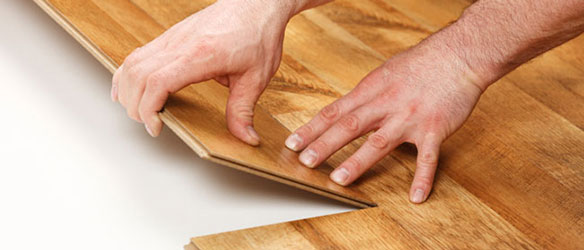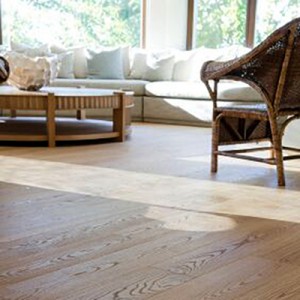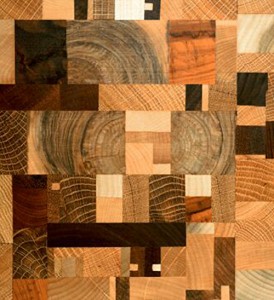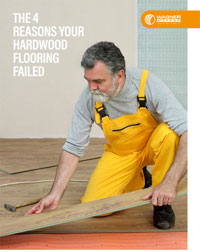Ambient Conditions and Wood Flooring Movement
 Wood shrinkage or swelling occurs when the wood’s moisture content (MC) levels oscillate due to changing ambient relative humidity (RH) and temperature.
Wood shrinkage or swelling occurs when the wood’s moisture content (MC) levels oscillate due to changing ambient relative humidity (RH) and temperature.
Any combination of RH and temperature will yield what is called an equilibrium moisture content (EMC). The calculated EMC for an ambient environment is the MC level to which a piece of wood will attempt to equalize (equilibrate).
Wood’s hygroscopic nature is the reason it can change MC due to changing EMC: stated very simply, wood’s open cell structure means it contains inherent pathways for moisture to enter and leave the wood.
This means that wood’s MC is always trying to acclimate according to its surrounding environment (EMC). When installing hardwood floors, even engineered flooring, measuring and managing the MC means controlling the degree to which these subtle shifts in EMC affect the flooring.
Shrinkage and Swelling due to Changing EMC
 Shrinkage and swelling due to changing EMC is especially relevant to the process of installing wood floors. When it is delivered, wood flooring is moved from one environment to another. Once delivered, the wood flooring’s MC levels can ultimately (given exposure and time) equal the EMC of the home or building. Functioning heating, ventilation, and air-conditioning (HVAC) systems provide a more stable environment but can also alter the EMC levels during ongoing seasonal changes as well. When homes are heated in the winter months, the EMC can decrease substantially. This type of change to the wood flooring’s environment can cause boards to shrink, which can manifest as small gaps or cracks between the boards.
Shrinkage and swelling due to changing EMC is especially relevant to the process of installing wood floors. When it is delivered, wood flooring is moved from one environment to another. Once delivered, the wood flooring’s MC levels can ultimately (given exposure and time) equal the EMC of the home or building. Functioning heating, ventilation, and air-conditioning (HVAC) systems provide a more stable environment but can also alter the EMC levels during ongoing seasonal changes as well. When homes are heated in the winter months, the EMC can decrease substantially. This type of change to the wood flooring’s environment can cause boards to shrink, which can manifest as small gaps or cracks between the boards.
Why? Because the ambient EMC changes will eventually also cause internal changes to the wood. Wood dimensions change due to the fluctuating MC of the wood flooring. When ambient EMC rises, wood flooring absorbs moisture from the air. Thus, wood dimensions expand. When EMC declines, wood dries out, and the flooring can shrink. The more extreme the shift in the environmental (ambient) EMC, the more noticeable the change in the flooring will be. Small changes will typically go unnoticed, but drastic changes may mean some serious moisture-related problems for your flooring. This fundamental knowledge is vital not only for MC measurement and management while installing hardwood floors, but also in managing the wood flooring’s MC regularly to guarantee end product strength and performance over many years.
Moisture Meter Use during Installation
Upon delivery, wood flooring should be allowed to acclimate to its surrounding environmental conditions until it reaches its EMC. This is where the wood is in balance with the RH and temperature of its surrounding environment and neither gaining nor losing moisture. Installers can utilize moisture meters for wood to measure the wood flooring’s MC during that time and ensure that the flooring reaches its EMC prior to installation. Moisture meters provide a quick and convenient way to make sure that the MC falls within manufacturers’ specifications. It’s an investment in the quality of the installation and the overall future life of the floor.
Moisture Assessment & Other Tips
Other factors also exert distinct influences over wood movement in fluctuating EMC conditions.
 Wood Species: All 1600-plus species have their own shrinkage/swelling characteristics, and this shrinkage/swelling is dictated by MC changes in the wood
Wood Species: All 1600-plus species have their own shrinkage/swelling characteristics, and this shrinkage/swelling is dictated by MC changes in the wood
Anisotropic characteristics mean that woods structures and properties can vary in different directions. This refers to the ways in which wood dimensions change in three directions: longitudinally, tangentially and radially. If possible, it is wise to become familiar with the general anisotropic concepts of wood dimension changes.
Typically, woods’ shrinkage values are as follows: tangential shrinkage is generally about twice as large as radial shrinkage. Longitudinal shrinkage ranges from one-tenth to one-hundredth of either radial or tangential shrinkage. The result is uneven dimensional changes.
As an example, if the wood flooring is installed “tight” and there is no gap around the room’s inside perimeter to absorb expansion as the material gains moisture, the increase in width of each floorboard becomes cumulative, and causes the entire floor to “grow” by the sum of each piece’s individual movement. In cases of excessive shrinkage, unacceptable gaps can result between each flooring board.

Free Download – 4 Reasons Your Hardwood Flooring Failed
Moisture meters for wood can help to ensure that the wood flooring expansion and contraction falls within acceptable wood flooring parameters at varying MC levels. By using a moisture meter and predicting the movement, you can decide whether you should install the wood flooring “tight” or “loose” to absorb what you know will be an increase in material width.
Other building materials: Some moisture meters for wood can provide relative assessments of MC in other materials such as synthetic stucco, plaster, drywall, linoleum, ceramic tile, and insulation. While a wood moisture meter can only provide comparative readings in these materials, it may be worth investing in a multi-material moisture meter if the MC in these materials may also be contributing to the moisture environment causing undue wood flooring movement.
Measuring and managing the wood flooring’s MC on a regular basis enhances the wood flooring’s longevity.
Troy Edwards is Technical Service Supervisor for Wagner Meters, Inc., where he oversees manufacturing, quality control and IT service for their electronic measurement products for the building and construction industry. Troy holds an AAS in Electronics Technology and has over 20 years’ experience in various electronic manufacturing and production positions.
Related Posts via Taxonomies
Last updated on May 4th, 2021



